Page 57 of 83
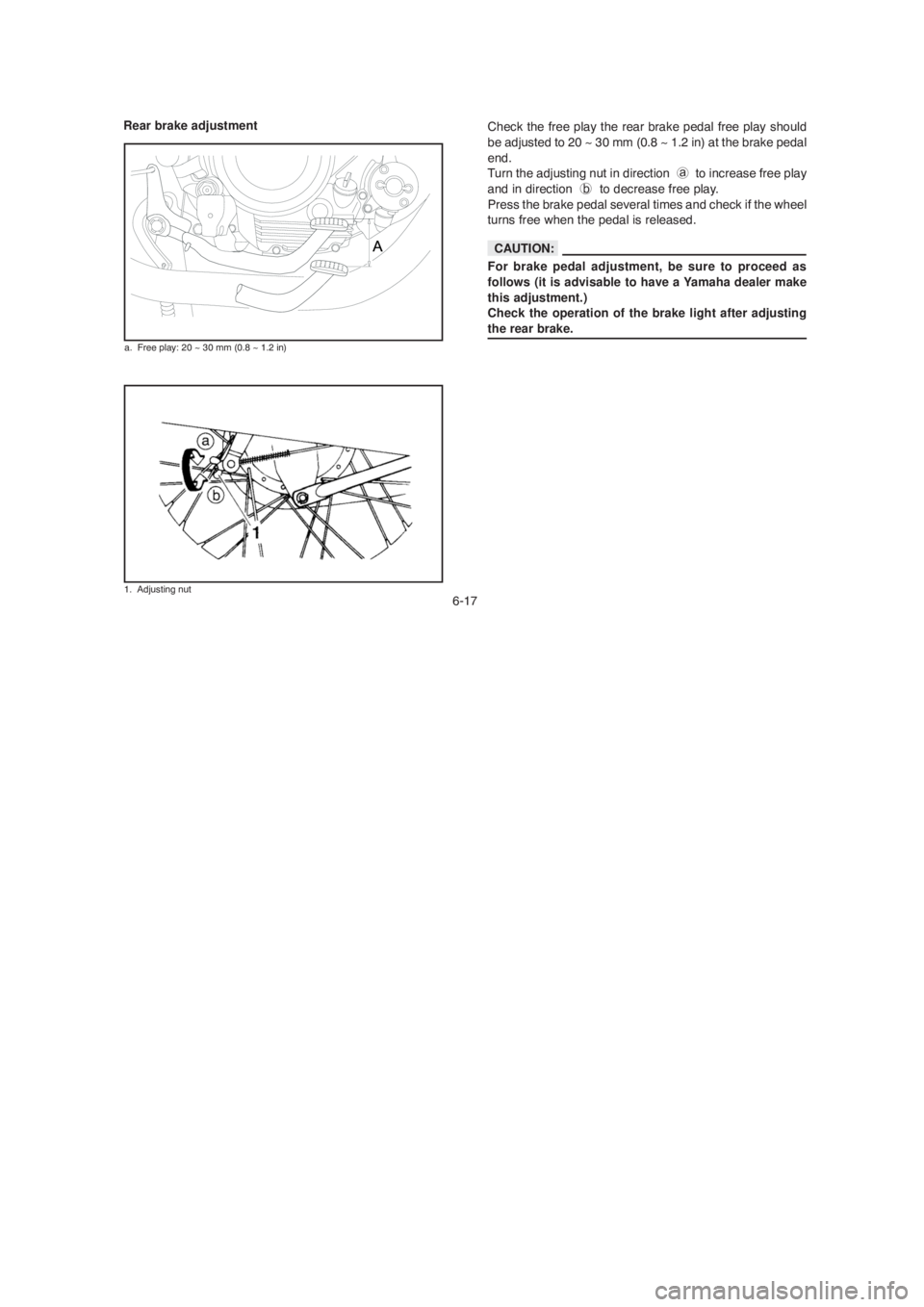
6-17
Rear brake adjustment
a. Free play: 20 ~ 30 mm (0.8 ~ 1.2 in)
Check the free play the rear brake pedal free play should
be adjusted to 20 ~ 30 mm (0.8 ~ 1.2 in) at the brake pedal
end.
Turn the adjusting nut in direction a to increase free play
and in direction b to decrease free play.
Press the brake pedal several times and check if the wheel
turns free when the pedal is released.
For brake pedal adjustment, be sure to proceed as
follows (it is advisable to have a Yamaha dealer make
this adjustment.)
Check the operation of the brake light after adjusting
the rear brake.
1. Adjusting nut
CAUTION:
6-17
Rear brake adjustment
a. Free play: 20 ~ 30 mm (0.8 ~ 1.2 in)
Check the free play the rear brake pedal free play should
be adjusted to 20 ~ 30 mm (0.8 ~ 1.2 in) at the brake pedal
end.
Turn the adjusting nut in direction a to increase free play
and in direction b to decrease free play.
Press the brake pedal several times and check if the wheel
turns free when the pedal is released.
For brake pedal adjustment, be sure to proceed as
follows (it is advisable to have a Yamaha dealer make
this adjustment.)
Check the operation of the brake light after adjusting
the rear brake.
1. Adjusting nut
CAUTION:
Page 58 of 83
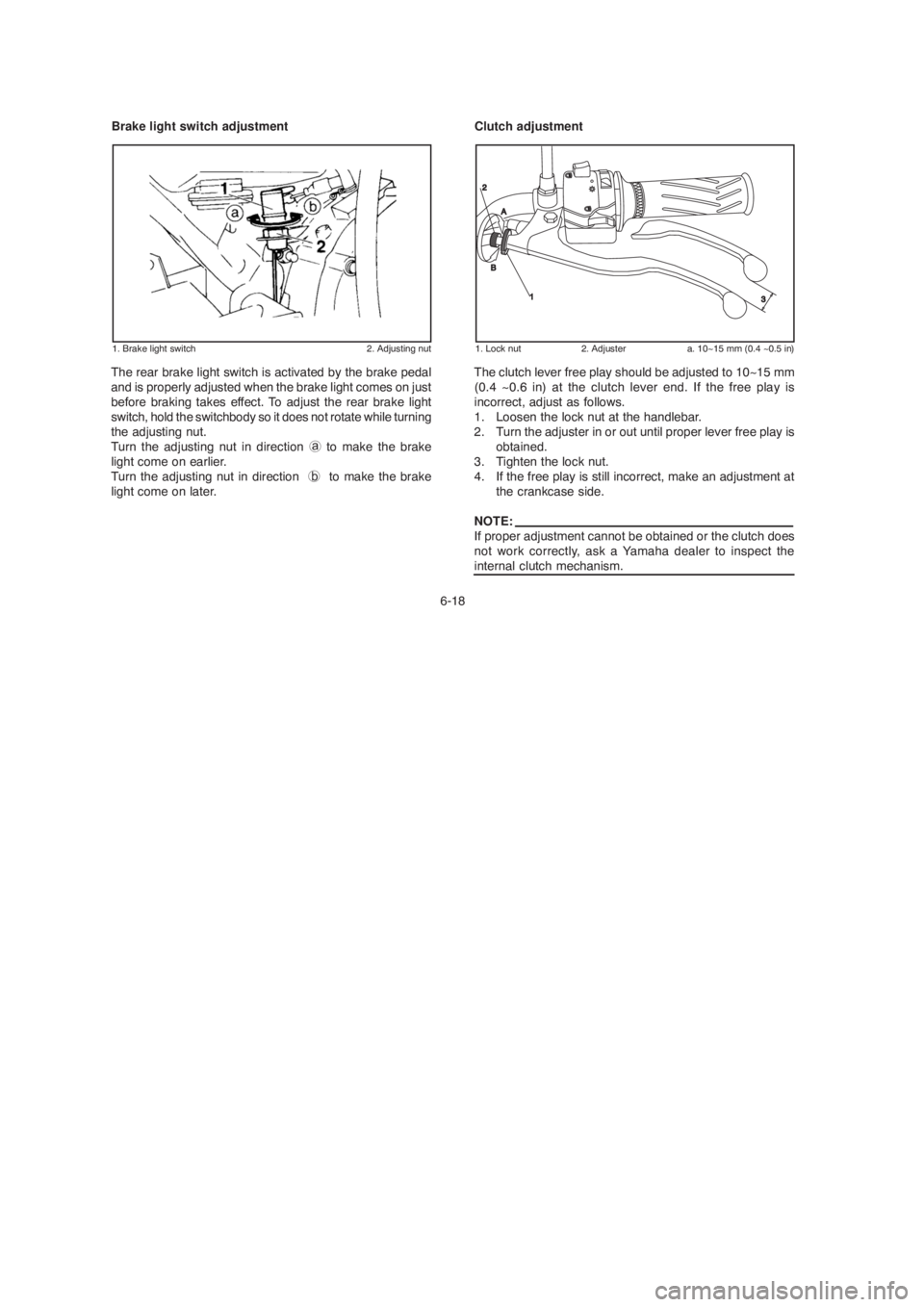
6-18
Brake light switch adjustment
The rear brake light switch is activated by the brake pedal
and is properly adjusted when the brake light comes on just
before braking takes effect. To adjust the rear brake light
switch, hold the switchbody so it does not rotate while turning
the adjusting nut.
Turn the adjusting nut in direction a to make the brake
light come on earlier.
Turn the adjusting nut in direction b to make the brake
light come on later.
1. Brake light switch 2. Adjusting nut
Clutch adjustment
The clutch lever free play should be adjusted to 10~15 mm
(0.4 ~0.6 in) at the clutch lever end. If the free play is
incorrect, adjust as follows.
1. Loosen the lock nut at the handlebar.
2. Turn the adjuster in or out until proper lever free play is
obtained.
3. Tighten the lock nut.
4. If the free play is still incorrect, make an adjustment at
the crankcase side.
NOTE:
If proper adjustment cannot be obtained or the clutch does
not work correctly, ask a Yamaha dealer to inspect the
internal clutch mechanism.
1. Lock nut 2. Adjuster a. 10~15 mm (0.4 ~0.5 in)
6-18
Brake light switch adjustment
The rear brake light switch is activated by the brake pedal
and is properly adjusted when the brake light comes on just
before braking takes effect. To adjust the rear brake light
switch, hold the switchbody so it does not rotate while turning
the adjusting nut.
Turn the adjusting nut in direction a to make the brake
light come on earlier.
Turn the adjusting nut in direction b to make the brake
light come on later.
1. Brake light switch 2. Adjusting nut
Clutch adjustment
The clutch lever free play should be adjusted to 10~15 mm
(0.4 ~0.6 in) at the clutch lever end. If the free play is
incorrect, adjust as follows.
1. Loosen the lock nut at the handlebar.
2. Turn the adjuster in or out until proper lever free play is
obtained.
3. Tighten the lock nut.
4. If the free play is still incorrect, make an adjustment at
the crankcase side.
NOTE:
If proper adjustment cannot be obtained or the clutch does
not work correctly, ask a Yamaha dealer to inspect the
internal clutch mechanism.
1. Lock nut 2. Adjuster a. 10~15 mm (0.4 ~0.5 in)
Page 59 of 83
6-19
Drive chain slack check NOTE:
Spin the wheel several times and find the tightest position
of the chain. Check and/or adjust the chain slack while it is
in this tightest position.
To check the chain slack the motorcycle must be held
straight up with both wheels on the ground and without rider.
Check the slack at the position shown in the illustration.
Normal slack is approximately 20 ~ 30 mm ( 0.8 ~ 1.2 in). If
the slack exceeds 30 mm ( 1.2 in), adjust.
a. 20 ~ 30 mm (0.8 ~ 1.2 in)
6-19
Drive chain slack checkNOTE:
Spin the wheel several times and find the tightest position
of the chain. Check and/or adjust the chain slack while it is
in this tightest position.
To check the chain slack the motorcycle must be held
straight up with both wheels on the ground and without rider.
Check the slack at the position shown in the illustration.
Normal slack is approximately 20 ~ 30 mm ( 0.8 ~ 1.2 in). If
the slack exceeds 30 mm ( 1.2 in), adjust.
a. 20 ~ 30 mm (0.8 ~ 1.2 in)
Page 60 of 83
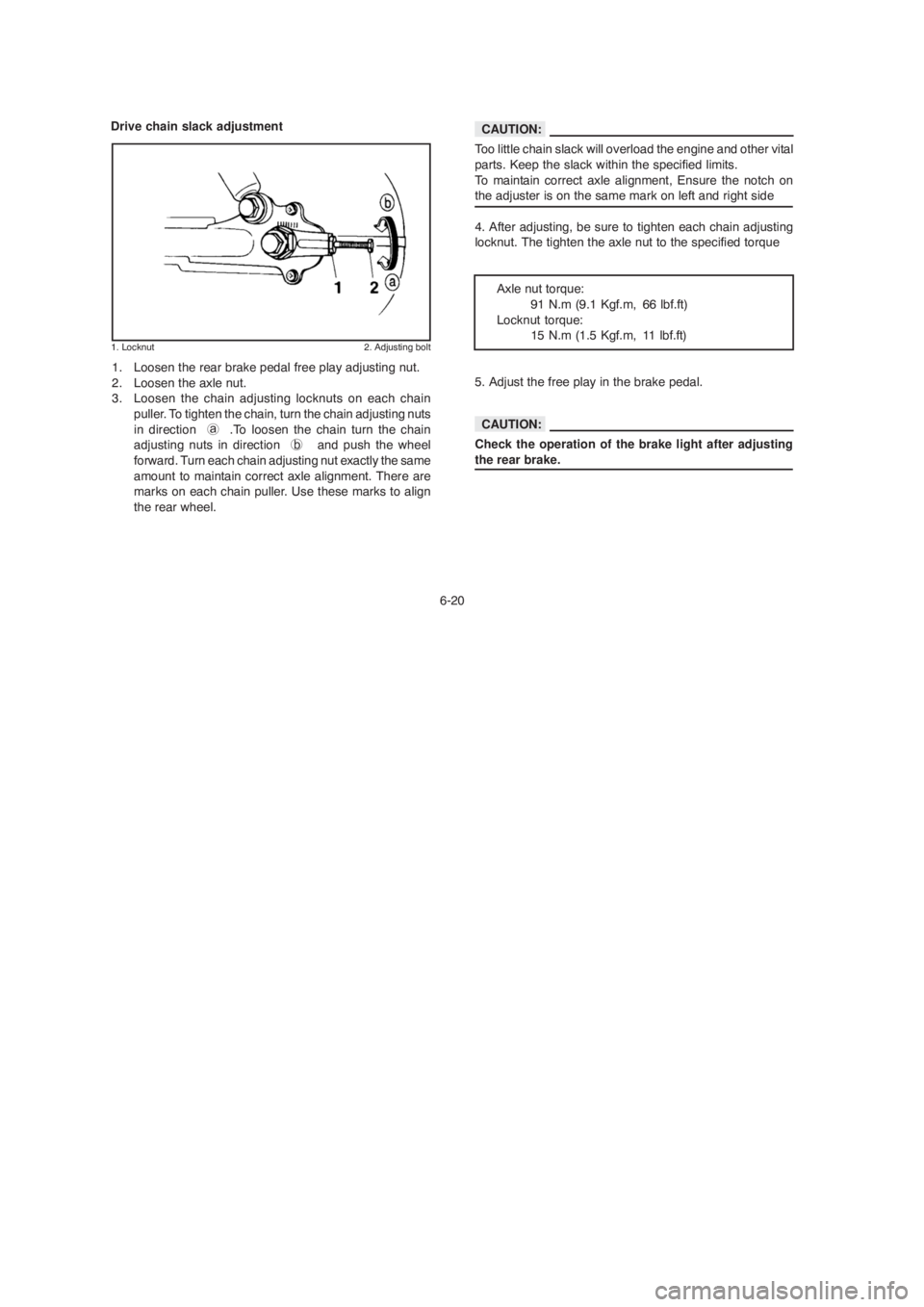
6-20
Drive chain slack adjustment
1. Locknut 2. Adjusting bolt
1. Loosen the rear brake pedal free play adjusting nut.
2. Loosen the axle nut.
3. Loosen the chain adjusting locknuts on each chain
puller. To tighten the chain, turn the chain adjusting nuts
in direction a .To loosen the chain turn the chain
adjusting nuts in direction b and push the wheel
forward. Turn each chain adjusting nut exactly the same
amount to maintain correct axle alignment. There are
marks on each chain puller. Use these marks to align
the rear wheel.Too little chain slack will overload the engine and other vital
parts. Keep the slack within the specified limits.
To maintain correct axle alignment, Ensure the notch on
the adjuster is on the same mark on left and right side
4. After adjusting, be sure to tighten each chain adjusting
locknut. The tighten the axle nut to the specified torque
Axle nut torque:
91 N.m (9.1 Kgf.m, 66 lbf.ft)
Locknut torque:
15 N.m (1.5 Kgf.m, 11 lbf.ft)
5. Adjust the free play in the brake pedal.
Check the operation of the brake light after adjusting
the rear brake.
CAUTION:
CAUTION:
6-20
Drive chain slack adjustment
1. Locknut 2. Adjusting bolt
1. Loosen the rear brake pedal free play adjusting nut.
2. Loosen the axle nut.
3. Loosen the chain adjusting locknuts on each chain
puller. To tighten the chain, turn the chain adjusting nuts
in direction a .To loosen the chain turn the chain
adjusting nuts in direction b and push the wheel
forward. Turn each chain adjusting nut exactly the same
amount to maintain correct axle alignment. There are
marks on each chain puller. Use these marks to align
the rear wheel.Too little chain slack will overload the engine and other vital
parts. Keep the slack within the specified limits.
To maintain correct axle alignment, Ensure the notch on
the adjuster is on the same mark on left and right side
4. After adjusting, be sure to tighten each chain adjusting
locknut. The tighten the axle nut to the specified torque
Axle nut torque:
91 N.m (9.1 Kgf.m, 66 lbf.ft)
Locknut torque:
15 N.m (1.5 Kgf.m, 11 lbf.ft)
5. Adjust the free play in the brake pedal.
Check the operation of the brake light after adjusting
the rear brake.
CAUTION:
CAUTION:
Page 61 of 83
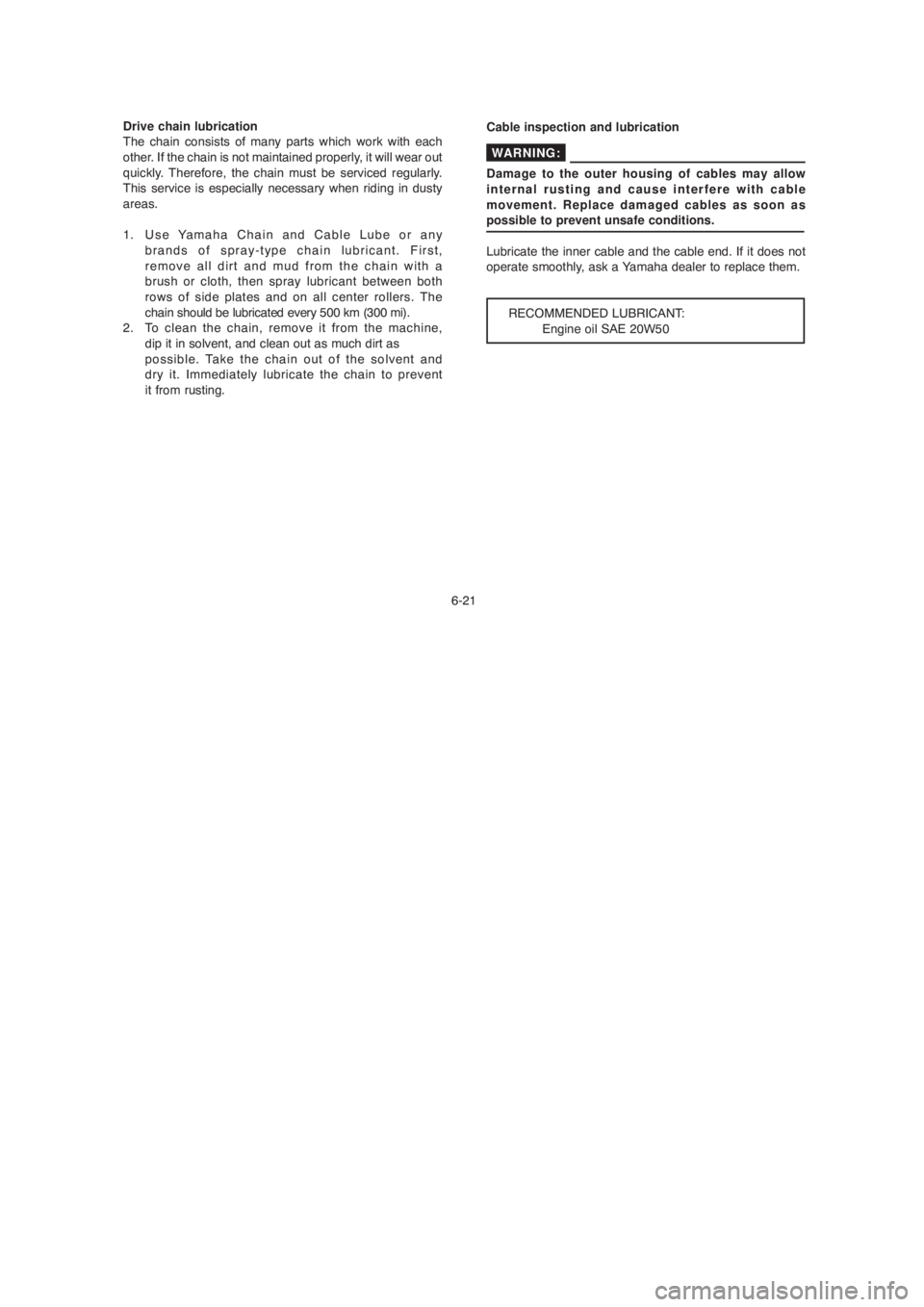
6-21 Drive chain lubrication
The chain consists of many parts which work with each
other. If the chain is not maintained properly, it will wear out
quickly. Therefore, the chain must be serviced regularly.
This service is especially necessary when riding in dusty
areas.
1. Use Yamaha Chain and Cable Lube or any
brands of spray-type chain lubricant. First,
remove all dirt and mud from the chain with a
brush or cloth, then spray lubricant between both
rows of side plates and on all center rollers. The
chain should be lubricated every 500 km (300 mi).
2. To clean the chain, remove it from the machine,
dip it in solvent, and clean out as much dirt as
possible. Take the chain out of the solvent and
dry it. Immediately lubricate the chain to prevent
it from rusting.Cable inspection and lubrication
Damage to the outer housing of cables may allow
internal rusting and cause interfere with cable
movement. Replace damaged cables as soon as
possible to prevent unsafe conditions.
Lubricate the inner cable and the cable end. If it does not
operate smoothly, ask a Yamaha dealer to replace them.
RECOMMENDED LUBRICANT:
Engine oil SAE 20W50
WARNING:
6-21 Drive chain lubrication
The chain consists of many parts which work with each
other. If the chain is not maintained properly, it will wear out
quickly. Therefore, the chain must be serviced regularly.
This service is especially necessary when riding in dusty
areas.
1. Use Yamaha Chain and Cable Lube or any
brands of spray-type chain lubricant. First,
remove all dirt and mud from the chain with a
brush or cloth, then spray lubricant between both
rows of side plates and on all center rollers. The
chain should be lubricated every 500 km (300 mi).
2. To clean the chain, remove it from the machine,
dip it in solvent, and clean out as much dirt as
possible. Take the chain out of the solvent and
dry it. Immediately lubricate the chain to prevent
it from rusting.Cable inspection and lubrication
Damage to the outer housing of cables may allow
internal rusting and cause interfere with cable
movement. Replace damaged cables as soon as
possible to prevent unsafe conditions.
Lubricate the inner cable and the cable end. If it does not
operate smoothly, ask a Yamaha dealer to replace them.
RECOMMENDED LUBRICANT:
Engine oil SAE 20W50
WARNING:
Page 62 of 83
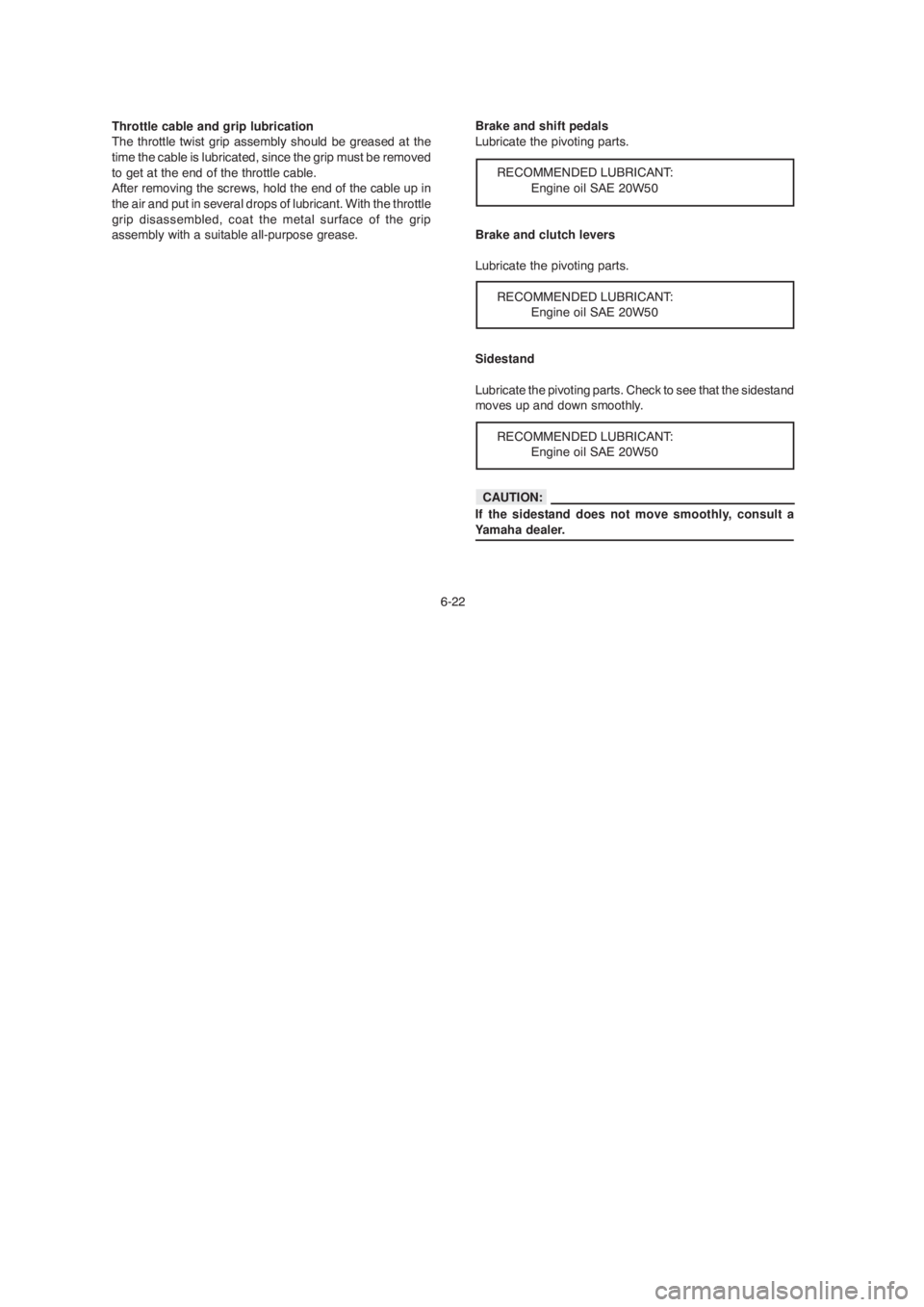
6-22
Throttle cable and grip lubrication
The throttle twist grip assembly should be greased at the
time the cable is lubricated, since the grip must be removed
to get at the end of the throttle cable.
After removing the screws, hold the end of the cable up in
the air and put in several drops of lubricant. With the throttle
grip disassembled, coat the metal surface of the grip
assembly with a suitable all-purpose grease.Brake and shift pedals
Lubricate the pivoting parts.
RECOMMENDED LUBRICANT:
Engine oil SAE 20W50
Brake and clutch levers
Lubricate the pivoting parts.
RECOMMENDED LUBRICANT:
Engine oil SAE 20W50
Sidestand
Lubricate the pivoting parts. Check to see that the sidestand
moves up and down smoothly.
RECOMMENDED LUBRICANT:
Engine oil SAE 20W50
WARNING:
If the sidestand does not move smoothly, consult a
Yamaha dealer.
CAUTION:
6-22
Throttle cable and grip lubrication
The throttle twist grip assembly should be greased at the
time the cable is lubricated, since the grip must be removed
to get at the end of the throttle cable.
After removing the screws, hold the end of the cable up in
the air and put in several drops of lubricant. With the throttle
grip disassembled, coat the metal surface of the grip
assembly with a suitable all-purpose grease.Brake and shift pedals
Lubricate the pivoting parts.
RECOMMENDED LUBRICANT:
Engine oil SAE 20W50
Brake and clutch levers
Lubricate the pivoting parts.
RECOMMENDED LUBRICANT:
Engine oil SAE 20W50
Sidestand
Lubricate the pivoting parts. Check to see that the sidestand
moves up and down smoothly.
RECOMMENDED LUBRICANT:
Engine oil SAE 20W50
WARNING:
If the sidestand does not move smoothly, consult a
Yamaha dealer.
CAUTION:
Page 63 of 83
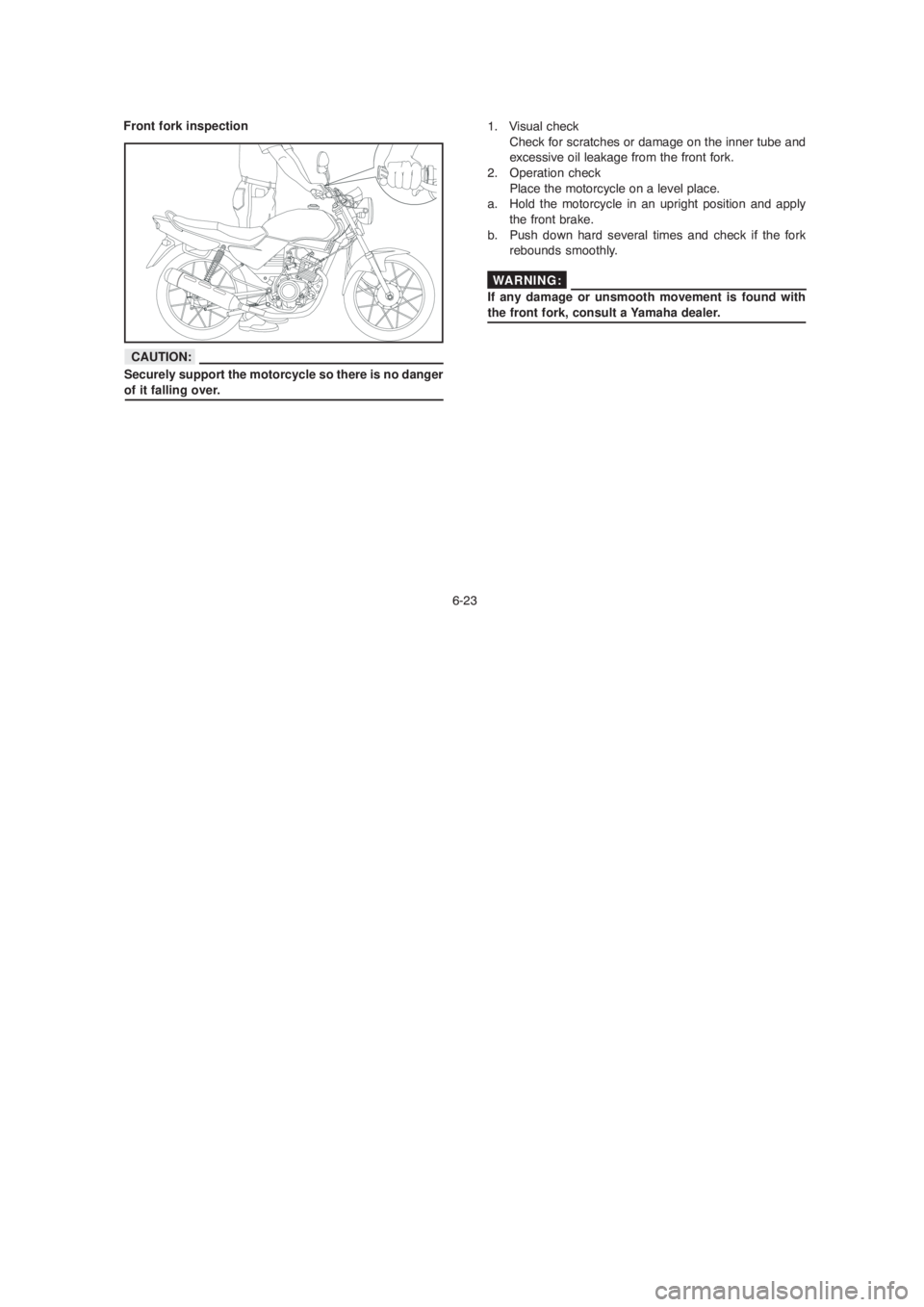
6-23
1. Visual check
Check for scratches or damage on the inner tube and
excessive oil leakage from the front fork.
2. Operation check
Place the motorcycle on a level place.
a. Hold the motorcycle in an upright position and apply
the front brake.
b. Push down hard several times and check if the fork
rebounds smoothly.
If any damage or unsmooth movement is found with
the front fork, consult a Yamaha dealer. Front fork inspection
Securely support the motorcycle so there is no danger
of it falling over.
CAUTION:
WARNING:
6-23
1. Visual check
Check for scratches or damage on the inner tube and
excessive oil leakage from the front fork.
2. Operation check
Place the motorcycle on a level place.
a. Hold the motorcycle in an upright position and apply
the front brake.
b. Push down hard several times and check if the fork
rebounds smoothly.
If any damage or unsmooth movement is found with
the front fork, consult a Yamaha dealer. Front fork inspection
Securely support the motorcycle so there is no danger
of it falling over.
CAUTION:
WARNING:
Page 64 of 83

6-24
Periodically inspect the condition of the steering. Worn out
or loose steering bearings may be dangerous. Place a stand
under the engine to raise the front wheel off the ground.
Hold the lower end of the front forks and try to move them
forward and backward. If any free play can be felt, ask a
Yamaha dealer to inspect and adjust the steering. Inspection
is easier if the front wheel is removed.
Securely support the motorcycle so there is no danger
of it falling over.Wheel bearings
If there is play in the front or rear wheel hub or if the wheel
does not turn smoothly, have a Yamaha dealer inspect the
wheel bearings. The wheel bearings should be inspected
according to the Maintenance Schedule.
Steering inspection
WARNING:
6-24
Periodically inspect the condition of the steering. Worn out
or loose steering bearings may be dangerous. Place a stand
under the engine to raise the front wheel off the ground.
Hold the lower end of the front forks and try to move them
forward and backward. If any free play can be felt, ask a
Yamaha dealer to inspect and adjust the steering. Inspection
is easier if the front wheel is removed.
Securely support the motorcycle so there is no danger
of it falling over. Wheel bearings
If there is play in the front or rear wheel hub or if the wheel
does not turn smoothly, have a Yamaha dealer inspect the
wheel bearings. The wheel bearings should be inspected
according to the Maintenance Schedule.
Steering inspection
WARNING: